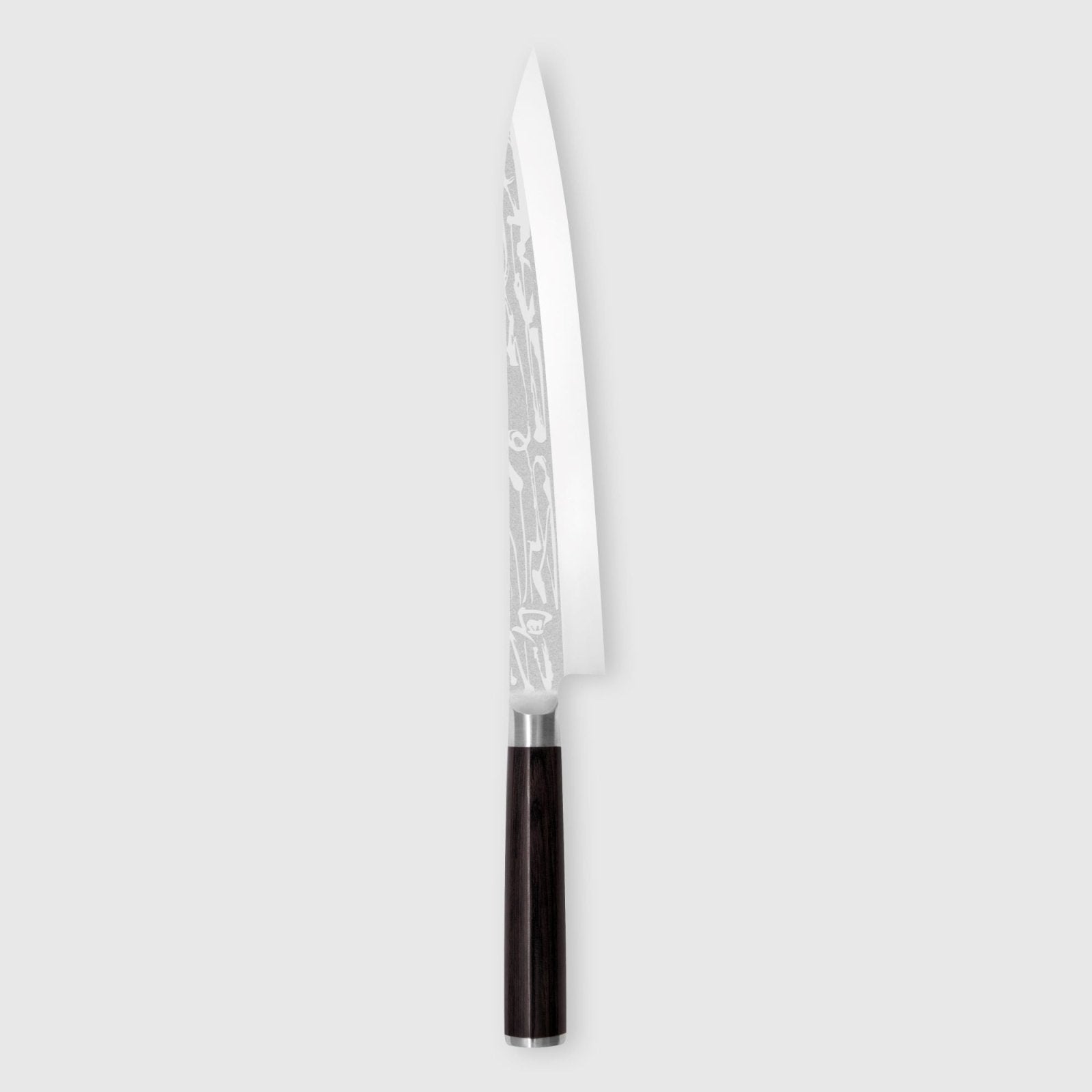
KAI SHUN PRO SHO
TRADITIONAL JAPANESE DESIGN
The KAI Pro Sho series exemplifies the pinnacle of traditional Japanese craftsmanship blended with cutting-edge manufacturing techniques, specifically tailored for the demands of continuous professional use. Each knife in the series is a homage to the singularly Japanese tradition of single-edged blade design, ensuring unparalleled sharpness and precision. Manufactured to exacting standards, these knives feature corrosion-resistant blade steels that guarantee longevity and enduring performance in the most rigorous kitchen environments. The series stands out not only for its functional excellence but also for its aesthetic appeal; each blade is adorned with an intricate ornamental pattern, a testament to innovative craftsmanship that forms the visual centerpiece of this exquisite collection.
In a seamless fusion of tradition and modernity, the KAI Pro Sho series marries classic Japanese design elements with contemporary functionality. The knives' elegant contours are highlighted by the use of black PakkaWood for the handles, offering a comfortable grip and enhanced durability, while contrasting beautifully with the elaborate patterns embossed on the blades. This striking design distinction earned the series a Special Mention at the 2019 German Design Award, recognizing its exceptional blend of style and practicality. The KAI Pro Sho series, with its perfect balance of aesthetic elegance and professional-grade performance, is an essential addition to the arsenal of any chef seeking to elevate their culinary artistry.
Key Features
- ROCKWELL RATING:61 (±1) HRC
- CRAFTSMANSHIP: Each knife from KAI is a product of meticulous handcrafting by skilled artisans
- HANDLE: Black PakkaWood
- BLADE MATERIAL: A 10 steel


KAI Shun Pro Sho 21cm Deba Knife


KAI Shun Pro Sho 16.5cm Usuba Knife


KAI Shun Pro Sho 16.5cm Deba Knife


KAI Shun Pro Sho 27cm Yanagiba Knife


KAI Shun Pro Sho 24cm Yanagiba Knife
FAQs
While it is true that Kai Corporation originated in Japan, not all its products are manufactured there. The company has expanded its operations globally over the years. However, many of their premium knife lines like Shun and Pro series are indeed crafted in Seki City, which has a 700 year legacy in blade mastery, where skilled artisans employ age-old techniques to create each blade.
The manufacturing process involves several stages including forging, tempering, sharpening and finishing - all carried out with meticulous attention to detail. This ensures that every knife that comes out of their factory meets the high standards set by Japanese blacksmithing tradition.
Single Edge
- Design: A single bevel knife has only one side of its blade sharpened, while the other side remains flat. This design is traditional in Japanese knives such as sashimi knives (Yanagiba), Deba, and Usuba, which is exactly what the Kai Shun Pro Sho features.
- Purpose: Single bevel knives are designed for specific tasks that require precision. For example, they are ideal for creating clean cuts in sushi and sashimi, offering unparalleled sharpness and control.
- Cutting Technique: The asymmetrical edge allows for extremely thin slicing and precise cuts. It's particularly favored in Japanese cuisine for preparing fish and vegetables.
- Maintenance: Sharpening a single bevel knife requires skill and understanding of the blade's geometry. They are usually sharpened at an acute angle, which varies from 15 to 30 degrees.
Double Edge
- Design: Double bevel knives have both sides of the blade sharpened, converging to a point at the edge. This design is common in Western-style knives like chef's knives, paring knives, and utility knives.
- Purpose: They are versatile and suited for a variety of kitchen tasks, including chopping, slicing, dicing, and mincing both meat and vegetables.
- Cutting Technique: The double bevel edge offers balance and ease of use, making it suitable for general culinary tasks across different cuisines. The sharpening angle for each side is usually between 20 to 25 degrees, providing a good mix of sharpness and durability.
- Maintenance: Double bevel knives are generally easier to sharpen than single bevel knives due to their symmetric edge. They can be maintained with standard sharpening tools like whetstones, honing rods, or electric sharpeners.
Conclusion
Choosing between a single or double bevel knife depends on your culinary needs and preferences. Single bevel knives excel in specialized tasks requiring precision and skill, favoured in traditional Japanese cuisine. Double bevel knives offer versatility and ease of use, making them a staple in both professional kitchens and home cooking environments worldwide.
Maintaining your Kai knives involves several essential practices to ensure they stay sharp, durable, and in top condition:
- Cleaning: Always wash your knives by hand with warm water and mild detergent immediately after use. It's important to avoid using the dishwasher, as the harsh environment can damage both the blade and the handle over time. After washing, dry the knives completely with a soft cloth to prevent any rust formation.
- Honing: Regular honing is key to keeping your knives sharp and maintaining their edge. Use a honing steel before or after each use to realign the blade's edge. Hold the steel vertically and gently slide the knife down and across the steel at a 20-degree angle.
- Sharpening: In addition to regular honing, your Kai knives will need periodic sharpening, typically once or twice a year depending on how frequently you use them. You can sharpen your knives using a whetstone, a handheld sharpener, or opt for professional sharpening services.
- Storage: Proper storage is crucial for the longevity of your knives. Store your Kai knives in a knife block, on a magnetic strip, or within protective sheaths. This not only prevents the blades from dulling but also helps avoid accidents. Storing knives in a drawer is not recommended, as they can easily get damaged.
- Cutting Surface: To maintain the sharpness of your knife edges, always use wooden or plastic cutting boards. Cutting on hard surfaces like glass, metal, or stone can quickly dull your knives.
- Avoid Misuse: Remember that these knives are specifically designed for cutting food. Avoid using them for any non-food related tasks, as this can damage the blade.
- Handle with Care: Always be mindful of the knife's balance and handle it with care. Avoid dropping or carelessly tossing your knives, as this can lead to damage to both the blade and the handle.
Shop at Cotswold Knife Company with confidence, knowing we are a verified stockist of Kai knives.

